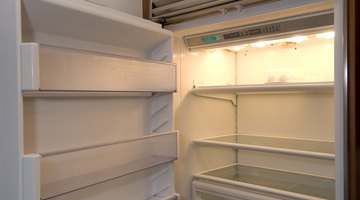How to Lubricate Refrigerator Door Gaskets
Like all rubber-based materials, refrigerator gaskets require routine maintenance to ensure that they do not become brittle or dirty to the point that they stick to the refrigerator. Brittle door gaskets form small cracks along their length.

Over time, the cracks will increase in size and reduce the ability of the gasket to seal the refrigerator door. An improper seal reduces the gaskets' ability to keep cold air from escaping the refrigerator. This causes the refrigerator to run more often, increasing your utility costs.
Things You Will Need
- Clean rag
- Soapy water
- Dry rag
- Petroleum jelly
-
Soak a clean rag in soapy water. Wring excess water from the rag.
-
Open the refrigerator door. Run the damp cloth along the perimeter of the refrigerator gasket. Ensure that the rag penetrates the multiple grooves running along the gasket. Stop cleaning when all dirt and food debris have been removed from the gasket.
-
Remove excess water from the gasket with a dry rag. Allow the gasket to air-dry for five to 10 minutes.
-
Apply a light coat of petroleum jelly to the top and front face of the gasket by dipping your finger in the jelly and rubbing it vigorously across all surfaces. Wipe any excess petroleum jelly from the area with the dry rag.
-
Close the refrigerator door.
The Drip Cap
- Like all rubber-based materials, refrigerator gaskets require routine maintenance to ensure that they do not become brittle or dirty to the point that they stick to the refrigerator.
- Over time, the cracks will increase in size and reduce the ability of the gasket to seal the refrigerator door.
- Open the refrigerator door.
- Remove excess water from the gasket with a dry rag.
References
Photo Credits
- Jupiterimages/Photos.com/Getty Images
- Jupiterimages/Photos.com/Getty Images
More Articles



